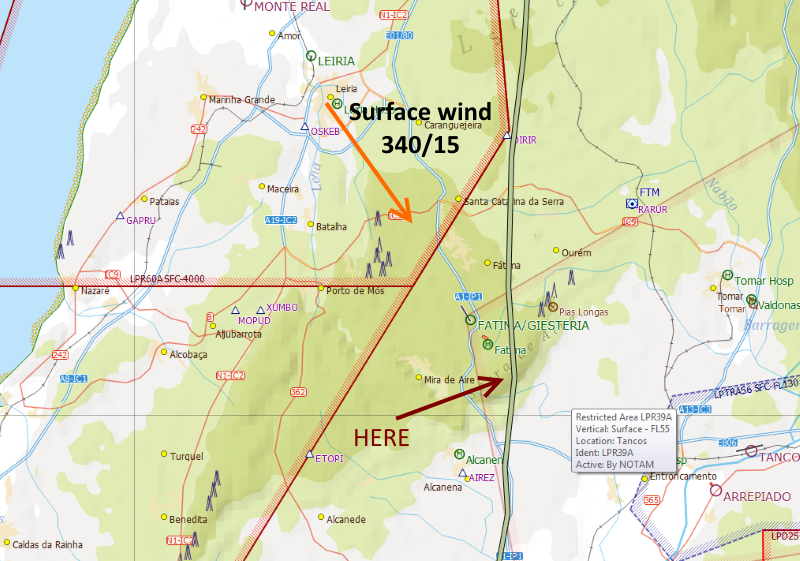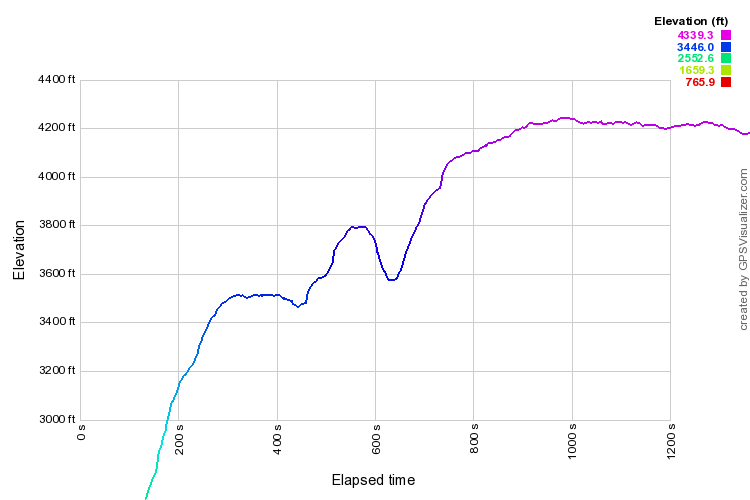Last Saturday I was flying back to my home airfield (Maia, LPVL north Portugal) from Santarem, when soon after take off I had to go over a hill south of Fatima. This was my track:

At the point shown above there is a hill that raises sharply to 2000 feet. Since it’s not a particularly high hill I really didn’t expect any problems. The surface wind was moderate at 340/15. After takeoff I levelled off at 3500 feet thinking it’s high enough to clear any hills and any bumps.
Few miles south of the hill, it started to get bumpy. Soon after I lost a little bit of height and then got into an updraft. I tried staying at 3500 by reducing power and pointing downwards. The airspeed increased greatly but I kept on going up! The updraft stopped at 3800 ft and few seconds after I got pulled down. I applied full power and set speed to climb however this time I couldn’t keep altitude and lost about 250ft over 1 min despite trying my best to climb. Loosing 250ft doesn’t sound bad, however it did feel like a very long minute especially when fighting to climb. During this time the ground felt really close! When this was finally over I got catapulted to 4200 feet, again despite efforts to keep level. After a while I stopped fighting it and stay at a high alt since it was smoother and class C started at 6000.
This is the elevation profile:

I’m a low hour PPL but I have flown over bigger hills at much stronger winds but I have never experienced anything like this. I suspect the topologoy and wind created the perfect conditions for a lee wave however I underestimated how strong it would be with such a small hill.
Do you guys have similar experiences? How did you react?
Even the small mountains (maximum height AMSL 2014ft) in the Isle of Man can generate quite strong mountain wave. I’ve soared the Auster in wave, going up 1000fpm in a definitely-not-a-glider. In Scotland, where the mountains are still not really huge, during wave season they get gliders up to FL330+ out of Deeside glider club.
One thing that might be counterintuitive is that it can be better to speed up in sink. If you pitch up for best climb (especially if the sinking air exceeds your best rate of climb) all you’ll do is prolong your time spent in sinking air, and you could lose more altitude compared to if you did nothing, or sped up to the top of the green arc. You’ll have to calculate it for your specific aircraft, but the benefit of speedinig up in sink generally gets higher as the rate of the sinking air gets higher (and also as the climb performance of your aircraft gets worse – e.g. flying solo vs flying at gross weight).
If you are VFR and there’s no airspace above you to run into, it may also be beneficial to slow down in the upgoing part of the wave and get a good bit of extra altitude. (Glider pilot mantra is slow down in lift, speed up in sink).
Do you guys have similar experiences?
Yes, on several occasions and in almost all levels. My most scary encounter was just north of the Alps in the general area of Salzburg with a strong southerly wind. It was in a C340 at around FL150 in IMC. The air was perfectly smooth and all we could see was the airspeed indicator going all the way from clean stall to red line and back several times as the autopilot was fighting to maintain the altitude. At the same rate, pitch was varying from -15 degrees to +15 degrees and back. We crossed a sequence of air masses that must have risen and descended at something like 2000ft/min. Wouldn’t have been much fun in a single so close to the (invisible!) mountains.
How did you react?
Either sat it out if it wasn’t too bad/scary or tried to get out of it, at such low levels usually by climbing. If that’s not possible, there is almost always a chance to fly further away from the hills. I guess you could also have asked for permission to enter airspace C? Otherwise you did the right thing: Don’t fight it and keep the airspeed within safe margings, even if that means gaining or losing a couple of feet. The lee waves (theoretically…) don’t reach all the way to the ground, so you can expect the downdraft to stop with some margin to the ground left.
The best thing to do is simply to maintain cruising airspeed. You will never be forced to the ground unless you try to fly 50 feet above a top or something.
When entering sink, you can always turn back into climb again. Mountain waves are very stable.
When going for longer trips the trick is to do what alioth writes. Speed up in sink and speed down in lift. With a little luck you can even fly with zero fuel consumption.
Not all hill turbulence, up draft, and downdraft is wave. I think most is non-wave. On Mogas, limited to below 6000’, and flying where hills go to over 3500’, I encounter a lot of turbulence. At my level I can avoid most of the downdrafts by choosing the up draft side of the hill where possible. Updrafts are smoother.
PS 200? miles downwind of South Island, New Zealand, an SR71 (top of the Cirrus range – outsourced to Lockheed) encountered wave at 70,000’.
Yes, on several occasions and in almost all levels. My most scary encounter was just north of the Alps in the general area of Salzburg with a strong southerly wind. It was in a C340 at around FL150 in IMC. The air was perfectly smooth and all we could see was the airspeed indicator going all the way from clean stall to red line and back several times as the autopilot was fighting to maintain the altitude. At the same rate, pitch was varying from -15 degrees to +15 degrees and back. We crossed a sequence of air masses that must have risen and descended at something like 2000ft/min. Wouldn’t have been much fun in a single so close to the (invisible!) mountains.
Had a similar experience cruising along the Brenner at FL65 – due to IFR procedures between Bolzen and Trento I was restricted to VFR below FL75; every time I came to a ridge below me, I had the same issue of the autopilot trying to hold altitude and taking the plane from red line to stall, it was just easier to stop using it and just use the adage – speed up in sink, slow down in a climb (whilst keeping below FL 75…)
In case of strong up- or downdraughts, one would never try to hold altitude (as long as you can mamage to stay above MSA). Even if it happens in CAS, just advise ATC you can’t hold altitude and request a block altitude.
Had the same in southern France flying from STP to MTL. Wind were more or less on the nose at 40kts. We were going up and down at a rate of 750’/min. I could not keep my level so left the aircraft to do as it wanted.